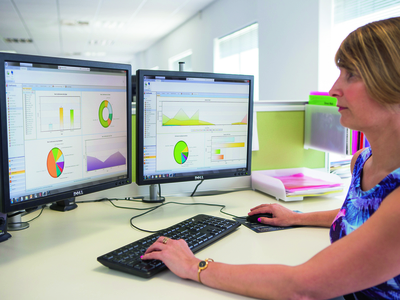Is web to print really just part of what of your MIS should be doing, or does it add something else to your business that MIS cannot do? What if you have not got an MIS but want web to print? Michael Walker looks at the developing relationship of these critical but complementary applications and the options open to printers.
In an ideal world, print jobs would be designed online or uploaded, an order made, a job ticket raised, stock picked, production time scheduled, the job printed, finished, packed, shipped and invoiced, without anyone entering any piece of information more than once, without any additional emails or phone calls being made, and with no human touches except for those parts of stock or print handling that have not been automated.
It is not an ideal world, but this ‘lights out’ production model has already been implemented in some places, according to Sean Whelan, EFI’s EMEA director of operations for Productivity Software. While not every job could ever lend itself to this degree of automation, and many printers like to take a look before any mistakes become too expensive to correct, it is the degree of integration between systems that provides the return on investment.
‘The printer’s margin goes up by having the customer doing much of the job management, specifying the print, uploading the job and providing the metadata so that the printer starts with a job that’s ready to be produced,’ Mr Whelan said.
Where the magic happens
To make all this happen, the key is to have a link between the web to print portal and the management information system. But what if you have not got web to print? Or if you have not got an MIS? Or neither?
MIS developers say that if you have not got one of their products then you have already got a big enough problem without a web portal bringing more jobs in. But there are print companies operating on Word, Excel or other home-brewed management information solutions who want to dip a toe in the web to print water without committing too much upfront.
‘MIS can be an expensive investment, as can add-on web to print modules,’ said John Davies, business development manager at Fujifilm, whose PrintCentre W2P portal is primarily used to pull jobs into the company’s XMF production workflow. ‘Companies may not be sure that it’s going to work and want a low entry cost to try it out.’
The MIS developers see it the other way around. ‘If you do MIS right, web to print is a logical extension to it,’ argues Optimus 2020 sales director Steve Richardson, adding: ‘Some go at it the other way, providing a good customer experience but then being unable to handle the production end.’
Jamie Thomson, managing director at web to print specialist RedTie, said: ‘You have to have the potential to integrate [with MIS] but it’s not necessary when you’re starting out; there’s plenty to learn about doing business online.’
What’s W2P for?
That begs the question of what you are trying to do with web to print. From the MIS perspective, an online portal is generally seen as a way of getting jobs set up and artwork into the existing system. It is an efficiency boost for the printer that also brings a more complete and cohesive experience for the customer, though it can also help win new business too.
Emerson Welch, marketing manager at MIS developer Clarity, which offers its own WebShop module, said: ‘It’s about optimising the customer’s time, browsing from looking to buying via one log-in with no double entry or jumping back and forth between systems.’
Trevor Cocks, managing director at Accura, is also a proponent of the seamless online customer experience: ‘A portal shouldn’t just be for designing or submitting artwork; customers expect to do everything online – quote, order, see order history and repeat jobs, sign off proofs or call off stock,’ he said.
To that list, web to print specialists such as Simon Ellington at ROI360 would add winning the business in the first place. ‘We see web to print as a tool to win new business, to secure long term relationships and to improve production efficiency – in that order,’ he said. ‘If you start with the last, you’re missing the point. It’s not just for the printer, it’s about the value-add that helps you win or retain more customers.’
ROI360 did some research on its customer base earlier this year to put numbers to those claims. Efficiency increases have been calculated to average 54 per cent, though one large customer saw upwards of 70 per cent improvement, while customer retention averages 70 per cent and average added order value for the group came to around £125,000. Anonymised data meant that individual customers could not be identified, but Mr Ellington suspects that those scoring highest on efficiency probably had their web to print linked to an MIS.
This is not too surprising, as once a web portal does start bringing extra work in, the requirement for better management of jobs makes itself felt pretty quickly. ‘Without MIS, it’s a big admin nightmare. As soon as you touch an order you’re eating into the profit – if it takes half an hour to set up the job sheet and half an hour to issue the invoice, where’s your profit? You become a servant to the website,’ said Trevor Cocks. RedTie’s Jamie Thomson agrees and sets the threshold where an MIS of some kind becomes a necessity at around 10 to 20 orders a day.
Who’s in charge here?
So if you have web to print and want to add an MIS that will communicate with it, what are your options? Most stand-alone web to print solutions will at the very least output data via XML for capture by the MIS, and many have APIs which allow two-way communication, though it requires somebody with programming and software development skills to implement this.

Coreprint from Vpress already supports this kind of integration with MIS offerings from Shuttleworth, Tharstern and EFI. The company recently announced a special tie-up with Optimus to provide full two-way communication between their respective offerings. This was largely as a result of repeated requests from customers of both companies, according to Vpress managing director Tim Cox, who also points out that sometimes the integration customers want is not just with MIS but with ERP systems based on heavyweight corporate database systems.
That said, Mr Cox adds: ‘Integration is not a prerequisite, web to print works without MIS very well. You could start with an investment of under £1000 and produce enormous savings that would subsequently justify the MIS investment, once you acknowledge that payment of integration costs is better than the employment costs of manual alternatives.’
EFI’s Sean Whelan agrees that web to print can be the ‘foot in the door’ that begins a series of automation and integration improvements; in his company’s case, the web to print software is often included in the deal with a Fiery RIP.
The integration between ‘equal partners’ does raise the issue of which system is in control: does the web to print portal drive the MIS or vice-versa?
Simon Ellington sees it as a case of having the right tool for the job. ‘If it’s a question about stock, the MIS should own it,’ he explained, ‘but if it’s the creation of an order from PageFlex Storefront, we would push that order to the MIS and possibly into a template like the Shuttleworth Master Estimate, for example.’
Getting components that have stand-alone histories to play nicely together is a major focus at EFI, which offers both a highly popular web to print portal in Digital StoreFront and a variety of MIS/ERP offerings including Pace and Monarch.
Don’t MIS the boat
Those who have the MIS – or who prefer to get it first – and are keen to get their business online have some additional options. DDS Accura and Clarity both offer web to print modules that extend access to the system to online customers. The former’s Accura Online component provides customers with access to their job data in the MIS, a web store for online ordering, artwork editing and online proofing and is a ‘weapon in the armoury for getting all of a customer’s business’ according to Trevor Cocks.
The Clarity Web to MIS option brings generic web to print benefits such as multiple stores run from one system, hidden/closed buying channels for B2B use and some novel order tracking features that include proof of delivery via tablet, or smartphone apps that enable pictures of installations to be added to invoices as well as made available for client inspection online.
Optimus offers its Cloud W2P module in addition to its recently-announced integration capability with Vpress. Shuttleworth does not develop its own web to print software but instead links with both Vpress and ROI PageFlex; integration with the latter at Harrogate-based Platinum Print was central to a major three-year contract win recently and has contributed to a 10 per cent increase in turnover in the last year.
EFI’s Sean Whelan says that now one in three Digital StoreFront web to print sales is to an existing EFI MIS customer, and that the proportion of customers seeking integration is growing steadily. Simon Ellington reckons that between a half and two-thirds of ROI360’s customers have MIS. Tim Cox at Vpress says that having MIS is ‘bordering on a no-brainer’. It seems that web to print and MIS are not only natural partners but are perhaps on their way to becoming facets of an altogether wider and deeper systems integration across print production that ranges from customer acquisition to invoicing and ongoing business, to the benefit of both printer and customer.





